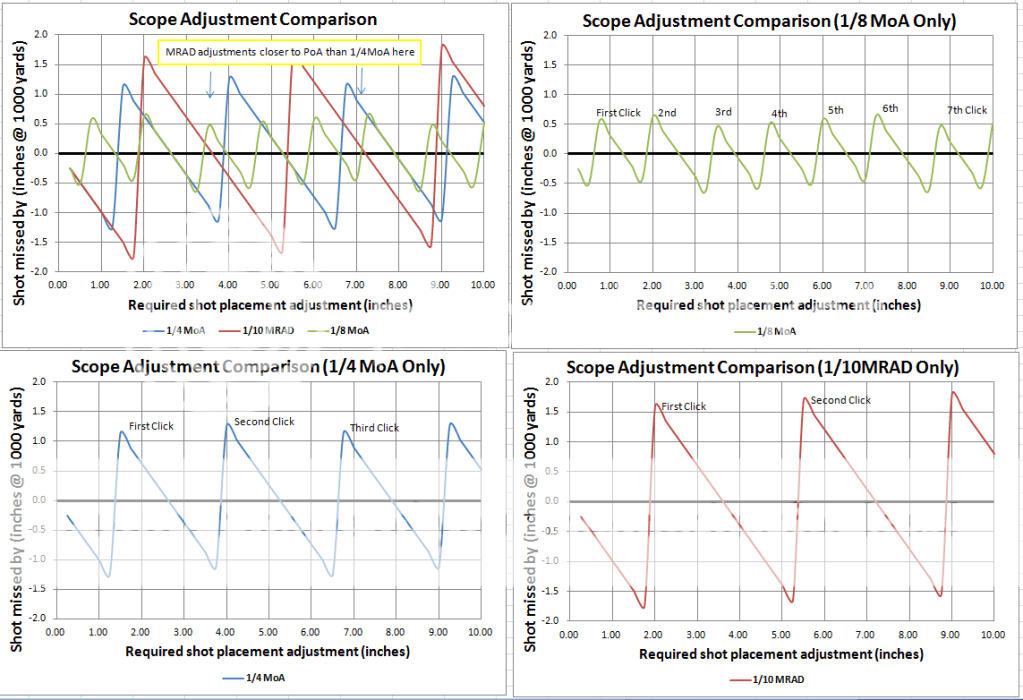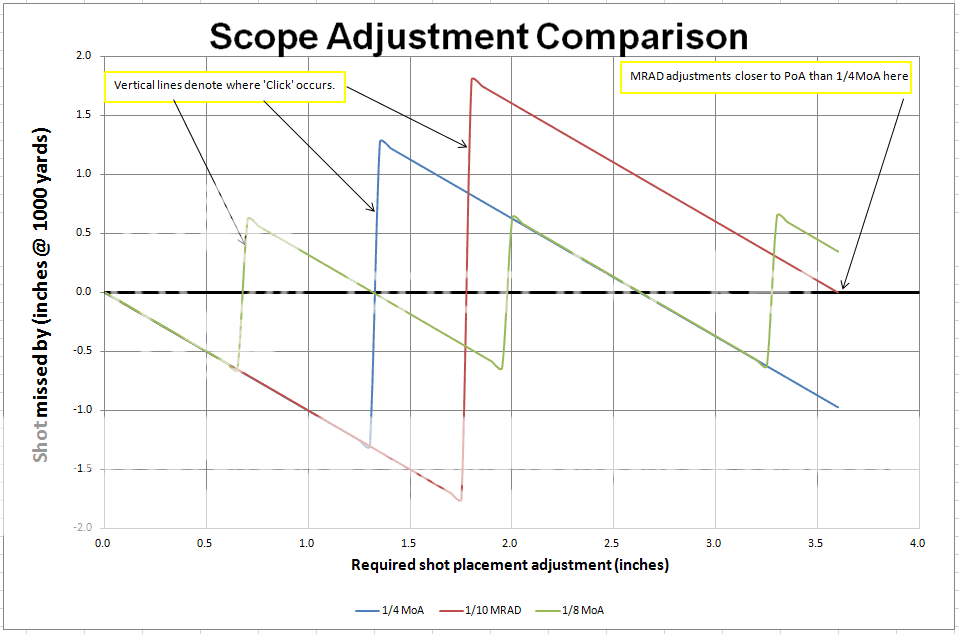emn83
Well-Known Member
I thought I was going to switch to MOA when I upgrade, now though, MILs ar starting to grow on me, I like MOA for doing my internal adjustments, but I like mill for using the reticle, does that make sense?
 Help Support Long Range Hunting Forum
Help Support Long Range Hunting Forum
After reading through your experiment I do understand what you're talking about and it does make sense. 1/4MoA adjustments will get you closer than 1/10MRAD adjustments will (most of the time). What I'm trying to figure out is just how bad MRAD adjustments are compared to MoA. Because I went to school for engineering and not arts and crafts, I let Excell do the work for me.
Whether you're shooting F-Class or pop cans, you will shoot, see where your shot hit, see where you want to hit, decide on how much adjustment to use based on your rifle's precision (usually divide miss distance by 2 or take 2nd shot at same Point of Aim). After all this, we all come to the same conclusion: adjust X.X clicks horizontally and X.X clicks vertically.
What I did was simulate a required adjustment for 0.25" to 10.00" at 1000 yards and applied the rounded click adjustment. Even the 1/8MoA adjustment won't get you exactly on target most of the time and there will be some error in PoA and PoI or group center.
I graphed the results as well as averaged to difference between the MoA and MRAD miss distance for comparison.
- 1/4 MoA vs 1/10 MRAD: 1/4 MoA will get you on average 0.28" closer to your PoA than 1/10 MRAD will. Extreme differences are 0.97" advantage to 1/4 MoA and 0.97" advantage to MRAD (depending on the required adjustment, see graph).
- 1/4 MoA vs 1/8 MoA: 1/8 MoA will get you on average 0.27" closer to your PoA than 1/4 MoA will. Extreme differences are 1.29" advantage to 1/8 MoA and 0.00" advantage to 1/4 MoA
- 1/8 MoA vs 1/10 MRAD: 1/8 MoA will get you on average 0.55" closer to your PoA than 1/10 MRAD will. Extreme differences are 1.32" advantage to 1/8 MoA and 0.35" advantage to MRAD (depending on the required adjustment, see graph).

Here's a refined picture for 0.1 MRAD or 3.6" at 1000 yards:

As you can see, it is a repeating series. There are certain required adjustments where 1/10 MoA will bring you closer to your PoA than 1/4 MoA and even closer than 1/8 MoA when an adjustment of about 3.6" and 7.2" is required (where the required adjustment equals 1 or 2 tenths of a mil).
So, basically, by going with a 1/10 MRAD adjustment scope instead of a 1/4 MoA one, you are only going to be off by an average of a quarter inch at 1000 yards due to scope adjustment coarsness (if that's even a word).
Hope that helps!
Ok, so im really not looking for a debate on what system is better. The fact is, they both have good features and in the right hands can work equally well. I get the idea though that people like Arron Davidson(Not knocking AD at all just a observation based on the fact his LRF does not give corrections in MIL.) have the preception that only tatical guys use MIL. So I would like to see how many use each system.
Moved from moa to mils several years ago. Haven't looked back. It's not like its difficult using either system. I simply prefer the smaller numbers of mils. "Thirty two and a quarter minutes" vs. "seven point six" is just a hell of a lot easier to talk about and deal with. Obviously the above measurements don't correlate... it's just a case in point.
Could we have an exmple of this? Haven't a clue here what you mean.
Thanks!
Jeff
The real advantage of a milrad scope is when you incorporate it with milrad rectical simply measure your miss by the milrad rectical eg miss by 1.2mils + or - 1.2mils on your scope it's that easy no math's and very fast and also gives you backup range finding ability
I.